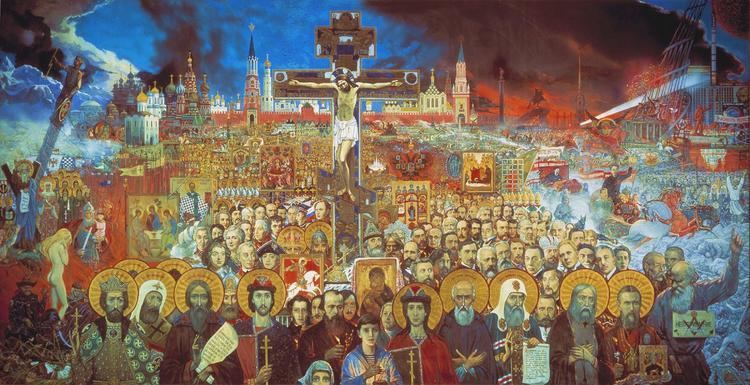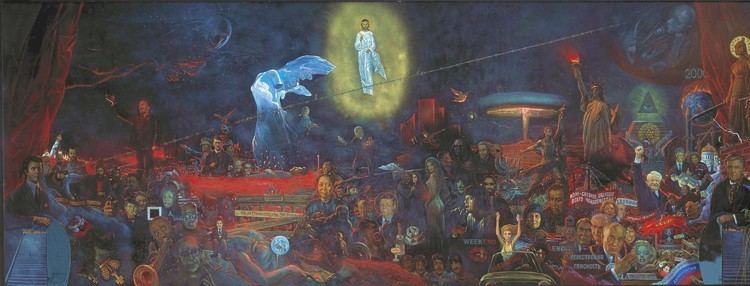Role Artist | Name Ilya Glazunov Known for painting | |
Awards People's Painter of the USSRPeople's Artist of RussiaState Prize of the Russian FederationOrder of Merit for the Fatherland (4th, 3rd and 2nd degree) Spouse Nina Vinogradova-Benois (m. 1956–1986) | ||
Education Imperial Academy of Arts | ||
Ilya Glazunov Painter Entranced by Russia's Past
Ilya Glazunov (Russian: Илья Глазунов; 10 June 1930 – 9 July 2017) was a Russian artist from Saint Petersburg. He was the founder of the Russian Academy of Painting, Sculpture and Architecture in Moscow (Russian: Российская академия живописи, ваяния и зодчества) where he also served as a rector up until his death. He held the title of People's Artist of Russia.
Contents

Ilya Glazunov's paintings have mostly historic or religious themes. Famous works include Russia the Eternal, The 20th Century Mystery, The Ruining of the Temple on Easter Night, and illustrations to the works of Fyodor Dostoyevsky.

Ilya glazunov thinking
Biography

Ilya Glazunov was born in Leningrad (now Saint Petersburg) to Sergey Fyodorovich Glazunov and Olga Konstantinovna Glazunova (née Flug). Both of his parents originally belonged to Russian nobility. His father was a historian. As a child, Glazunov visited a children's school of arts, and later a secondary art school in the historical district of Petrogradskaya Storona.

During the Great Patriotic War he survived the Siege of Leningrad. His father, mother and other relatives died in it. In 1942 the then-eleven-year-old was transported from besieged Leningrad along the Road of Life. He stayed in the village of Greblo in the Novgorod region. In 1944 he returned to Leningrad and studied in the Leningrad Secondary Art School. From 1951 to 1957 he studied art at the I. Repin Institute of Painting, Sculpture and Architecture under the direction of Professor Boris Ioganson.

In 1956, he married Nina Vinogradova-Benois. He painted the image of Nina in many of his works. Nina Aleksandrovna was a descendant of the Benois family, a familiar name in art history. Her uncle was the artistic director of the La Scala Opera for 30 years. On 24 May 1986, Nina Vinogradova-Benois committed suicide, just a few days before the opening of the exhibition of her husband in Manege. Their children, Ivan and Vera, have both become artists.
Glazunov's success at the International Competition of Young Artists in Prague prompted the opening of his first single exhibition in Moscow in 1957. Soon after in the 1960s, he traveled to Italy for the first time to paint the portraits of many famous actors and actress, including Gina Lollobrigida and Anita Ekberg. He also painted portraits of many political leaders, including Indira Gandhi, Leonid Brezhnev, Urho Kekkonen, Yury Luzhkov and Andrei Gromyko. In 1978, Glazunov started teaching in the Moscow University of Art. In 1987 he founded the Russian Academy of Painting, Sculpture and Architecture.
Ilya Glazunov was known for his active political position dictated by his patriotic, monarchistic and anti-democratic views. During the 1970s he stood against the General plan for restoration of Moscow that threatened to ruin the historical site of Moscow. Together with Vyacheslav Ovchinnikov he gathered signatures of prominent scientific and cultural figures under a letter of protest that was sent to the Politburo. The project was made public then, heavily criticized and, as a result, cancelled. This also led to the creation of the civil committee that monitored other reconstruction plans. Glazunov was one of the main advocates behind the restoration of the Cathedral of Christ the Saviour and one of the co-founders of the All-Russian Society for Protection of Historical and Cultural Monuments (VOOPIiK).
Glazunov died from heart failure on 9 July 2017 at the age of 87. He will be buried at the Novodevichy Cemetery on July, 11.
Works
Illustrations for F. Dostoyevsky's novel The Brothers Karamazov:
Honors
A minor planet, 3616 Glazunov, discovered by Soviet astronomer Lyudmila Zhuravlyova in 1984, is named after him.
